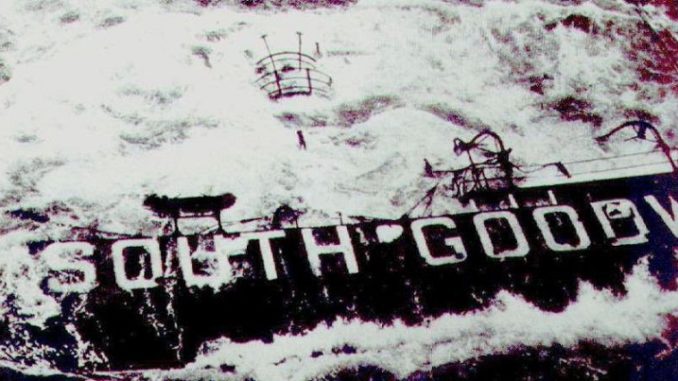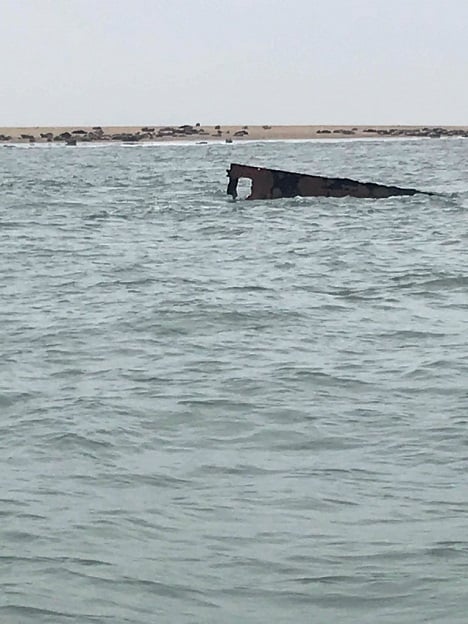
With many thanks to Ramsgate RNLI for this article
On this day 65 years ago the South Goodwins Lightvessel capsized with the loss of all crew, bar just one survivor who was a birdwatcher from the Ministry of Agriculture and Fisheries and happened to be on deck at the time.
Ramsgate RNLI’s current coxswain Ian Cannon’s grandfather Robert (Bob) Cannon was mechanic at the time, and the memory of that night stayed with him for the rest of his life.
During one of the worst channel storms in two centuries, No. 90 Lightvessel foundered upon the Goodwin Sands during the night, losing all seven crewmen as storm waves parted the vessel’s mooring cable, dragging it from its position at the north end of the narrowest point of the Dover Straits.
The alarm was raised by Deal Coastguard who reported the South Goodwin light extinguished, the visibility being good, despite the wind.
At 01.15 the Coastguard reported the lightvessel was suspected of being off-station;
At 02.30 the Ramsgate lifeboat was launched, followed at 02.50 by the Dover boat.
At Harwich the Trinity House Chief Superintendent ordered Captain R N Thompson to sail and THV Vestal left her berth at 05.30, steaming south at her best speed.
In daylight, the lifeboats found the lightvessel 6.5 miles to the northward of her Assigned Position, driven on to the sands, close to the Kellett Gut where she had rolled on her side. At 07.00 an American helicopter from RAF Manston flew over the wreck and at 08.00 the BBC Home Service reported the disaster.
The wind remained strong, heavy seas were breaking over the wreck and none of the lifeboats were able to get near the stricken lightvessel lying on her side in the shallows.

Several passes were made by the helicopter before a single figure, dressed in pyjamas, was seen clinging to the rails. Only Ronald Murton, a visitor from the Ministry of Agriculture and Fisheries, would survive the night. Lifeboats and a helicopter managed to secure the visitor, found clinging to the side of the vessel, but no other men would be found.
After 27 November, the international maritime community was quick to rally around with commiserations. Trinity House was fortunate enough to meet recently with Mr. and Mrs. J Park; Mr. Park is the son of the late Major Paul Park, the commanding officer of the American helicopter that led the rescue efforts. The Parks very kindly presented to Trinity House a number of archival mementos from the outpouring of gratitude that was due the brave rescue team after their efforts.
The men that crewed the South Goodwin lightvessel were Thomas Skipp from Coggeshall, Essex; Kenneth Lanham from Bow, East London; Sidney Philpott from Ramsgate, Kent; Walter Viney from Plaistow, East London; George Cox from Gorlestone, Norfolk; Thomas Porter from Holbrook, Suffolk; and Henry Lynn from Dovercourt, Essex.
(Credit to Askett for the information)

Also 37 years ago this week – Ian Cannon and his dad Ron were on board the Ross Revenge (November 20, 1991) when her main anchor failed and she found herself grounded on The Goodwin Sands, the notorious sandbanks located off the Kent coast.
The crew immediately contacted Dover Coast Guard and within a few hours were airlifted by helicopter to RAF Manston.
03:40 – Ross Revenge grounded on Goodwin Sands
04:45 – Dover Harbour Board tug Dextrous deployed to rescue.
05:35 – Ramsgate lifeboat arrive at the request of Dover Harbour Board – Ross Revenge crew make contact.
06:58 – Ramsgate lifeboat runs aground on Goodwin Sands but manages to free herself.
06:57 – RAF Sea King helicopter winched all Ross Revenge crew off the ship and returned to RAF Manston.

